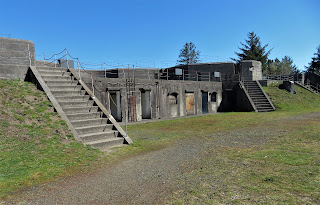Learning the ropes
We have contemplated camp hosting or volunteering at state parks for quite a while. Last summer on our tour of Oregon, we took a closer look at the parks, job descriptions and opportunities. We decided to sign up at several different parks in different positions. The positions fill early but often have cancellations. A few things we look at when choosing a park was how far the grocery stores were, how close hiking is and the bike riding routes available.
Some of the benefits of hosting in Oregon State Parks is staying in a great park for a month or more without charge, free nights in route and free entry into local museums. Plus we get to meet nice people and feel like we are contributing in a good way.
Things were pretty quiet even with spring breaks in Oregon and Washington.
Our first position is Fort Stevens State Park located on the northwest corner of Oregon where the Columbia River meets the Pacific Ocean. Our job is to sell firewood 5 days a week from 4-8pm. Our trailer is right next to the wood bin. On slow days, which is most of April except the weekends, we put out the sign to check with the hosts in site H1, our site. We just enjoy the rest of the day.
 |
| Western Skunk Cabbage |
 |
| This eagle was huge sitting high in a tree along the river. |
The 4200 acres of this state park is larger than we had realized with over 500 campsites, making it the largest in the western US. It is well laid out and everyone has plenty of room. This takes a lot of different types of camp hosts. Right now there are only 12 sites with host but goes up to 25 in the busy season. Some people's jobs are to ride around or walk and pick up trash and be available to answer people's questions. It is much about having an official presence on each loop.
We like watching the pilots board the large ships as they enter the Columbia River and the tug boats that pull them along.
Initially constructed during the Civil War, Fort Stevens remained active through World War II. Sea mines were used as a means to defend the river’s mouth from enemy intrusion. The mines were attached to the bottom of the river by cables, then detonated by remote control from an on-base switchboard. Everything associated with the mines, with the exception of the explosives, were kept within the Mine Cable Storeroom.
The miles of bike trails are well maintained and wind all through the woods in the park and are well used by the families. Our morning walk to the shipwreck beach is one mile each way and the trail around the Coffinbury Lake is 2 miles around. We stopped at the lake on our return walk from the ocean to watch the Osprey diving into the lake and pull out a fish.
Some days, we ride our bikes the 4 miles to the historic area and along the river's jetty. There are tours both in an Army truck and underground which we can take for free as volunteers.
We like being right near three towns making grocery shopping easy and less time consuming.
We do get a bar or two of Verizon which is fine most of the time for us. But get a very cool Blues station which we don't find very often in our travels. This station features artists we haven't heard in ages.
The Peter Iredale was a 19th century, 4-masted steel ship that ran aground in 1906 on the Clatsop Spit. Today it is considered one of the most accessible shipwrecks of the Graveyard of the Pacific.
 |
| Kites were flying high during spring break. |
We wake to the sound of fog horns of the ships going up the Columbia River from the Pacific Ocean in the morning marine layer. At night we are lulled to sleep by bullfrogs that can get pretty loud at times. We like it.


















